Why should organizations consider adopting industrial IoT?
Industrial IoT enables organizations to get a wealth of actionable data from their operations. When properly aggregated and analyzed, the data helps them better control operations, with the potential to:
- Improve worker safety
- Increase production uptime by predictive maintenance of machinery
- Maintain product quality
- Help ensure regulatory compliance
- Improve operational efficiencies
- Accelerate response times with real-time collection and processing of operational data
How is industrial IoT different from other types of IoT?
IIoT connects machines and devices in industries such as manufacturing, transportation, oil and gas, power generation and transmission, mines, and ports. Commercial, enterprise, or consumer IoT—also simply known as IoT—is used to describe connected devices within homes and office spaces, such as cameras, badge readers, and HVAC control systems.
Failure of IIoT can have catastrophic consequences, creating high risk and potentially life-threatening situations. Downtime of other IoT devices may result in inconveniences, but it does not usually cause emergency situations.
Major considerations for adopting IIoT
Depending on where an organization is in its digital transformation, it may need to replace analog information sources with digital, securely network these sources, and develop applications that can ingest the data and generate actionable insights.
Network equipment
The switches, routers, and wireless equipment that connect IIoT devices must provide the needed bandwidth and be able to withstand punishing physical conditions on factory floors or outdoors. This equipment must support the communication protocols in use to provide visibility and help monitor each endpoint. Network equipment should also be able to run edge applications to respond to emerging situations in real time and to extract, curate, and transmit operations data to applications in a data center or the cloud.
Explore Cisco Industrial IoT portfolio
Centralized connectivity deployment and monitoring
For organizations to efficiently monitor and scale their deployments, centralized visibility of device connectivity is of paramount importance. Organizations need to be able to deploy and configure connectivity to their edge devices and equipment quickly and accurately. They also need to efficiently update configurations by enabling secure remote access to equipment and troubleshoot issues by monitoring alerts.
Learn about Cisco Secure Equipment Access
Strong cybersecurity
All connected devices increase the threat surface. Operational devices are especially vulnerable, and an attack could have grave consequences. Robust security based on the zero-trust model is a must. This model requires you to establish trust parameters by identifying and profiling connected endpoints. You also segment the network into zones and continuously monitor each endpoint's behavior to make sure it remains trustworthy. If anomalous behavior is found that might indicate an endpoint is infected, you can then take appropriate steps to mitigate any risk.
See Cisco IoT/OT security solutions
The role of IT in industrial IoT
IIoT malfunctions can have a major impact on operations, ranging from production downtime to compromising worker safety or damaging the environment. IIoT installations benefit from rigorous IT processes, tools, and best practices. IT can scale and secure IIoT deployments to help ensure success.
A reliable network
Organizations rely more and more on the quantity and quality of data they get from their operations. IT must strive to ensure that a reliable network with sufficient bandwidth capacity is in place so time-sensitive data can be transmitted without delay to applications in data centers or the cloud.
The network that connects IIoT devices and sensors needs to support diverse physical channels. For example, although Ethernet cables may connect devices commonly found on the factory floor, wireless technologies such as 5G, 4G LTE, NFC, RFID, Bluetooth, NB-IOT, LoRaWAN, and Wi-SUN may also be required for connectivity.
Learn about Cisco IoT networking
Intelligent network control
The network for IIoT must be kept highly available. IIoT devices may be numerous and spread across a large geographical area, but a network controller can automate networking equipment deployment and keep configurations consistent, and firmware updated. It can also help ensure that devices are performing to expectations—and guide administrators to take corrective actions if not. Network controllers that have served IT well in the past could serve IIoT equally well.
Security for critical resources
As IT and IIoT networks converge, security practices must also converge. Protecting IIoT is best done with a comprehensive, integrated security solution rather than a multitude of point products. The same proven security tools that IT has deployed over the years can benefit IIoT as well.
